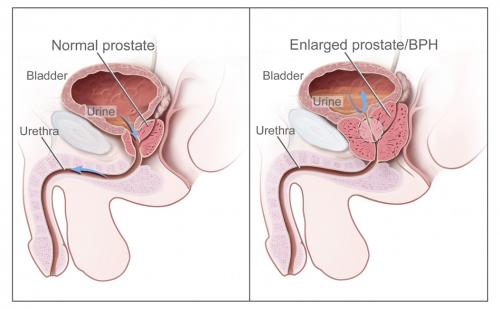Benign Prostatic Hyperplasia – Symptoms and Treatment

Benign
Prostatic Hyperplasia or BPH, and also known as benign prostatic hypertrophy is
a non-cancerous increase in the size of the prostate. The prostate gland
surrounds the urethra, the tube that carries urine from the bladder out of the
body. During the disease, as the prostate gets bigger, it may squeeze and
partly block the urethra, causing problems with urinating. Although BPH is not
a very serious problem, it can be a big nuisance. About half of all men over 75
have some symptoms, but it can occur in men of all ages.
Symptoms
Symptoms of
BPH usually are urinary problems, which include:
·
Trouble
getting a urine stream started and completely stopping it.
·
Perpetual
feeling of needing to urinate, which might even wake you up at night.
·
A
weak urine stream
·
The
feeling that the bladder is not empty after one urinates.
In some
cases of BPH, the enlarged prostate may completely block the urethra, making it
extremely hard or impossible to urinate. This may lead to urine backing up or
urinary retention, which can result in bladder infections, kidney stones or
kidney damage. BPH does not cause prostate
cancer and does not cause infertility related problems.
Treatment
Treatment
of BPH focuses on reducing its symptoms, and treatment is usually based on the
severity of the symptoms. Medical or surgical treatment is offered to men with
significant symptoms and includes:
·
Alpha
Blockers, which relax the smooth muscles of the prostate, and the bladder neck,
which helps to relieve urinary obstruction caused by an enlarged prostate in
BPH. These medicines generally take several weeks to lead to improvement in
symptoms.
·
5-Alpha
Reductase Inhibitors, block the conversion of the male hormone testosterone
into its active form in the prostate called dihydrotestosterone or DHT. The
prostate enlargement in BPH is directly dependent on DHT, so these drugs lead
to an approximate 25% reduction in prostate size over 6 to 12 months.
·
Transurethral
resection of the prostate, or TURPis a procedure that is being used since a
long time. In this procedure, the doctor inserts a special instrument into the
urethra through the penis. With the instrument, the doctor then shaves away
part of the inner prostate to relieve the outflow of urine from the bladder.
·
Laser
procedures, are now available in most high-end hospitals, some of which can be
performed in the doctor's office with minimal anaesthesia. These procedures
also involve the removal of obstructing prostate tissue. They are generally
associated with less bleeding and quicker recovery than TURP.
There are top hospitals in Gurgaon and NCR, with
the best urologists in Gurgaon and
NCR available there for treatment. The high-end multi-facility ones, like Paras
Hospitals Group have a hospital in Patna
as well with a special urology department.
Post Your Ad Here
Comments